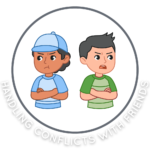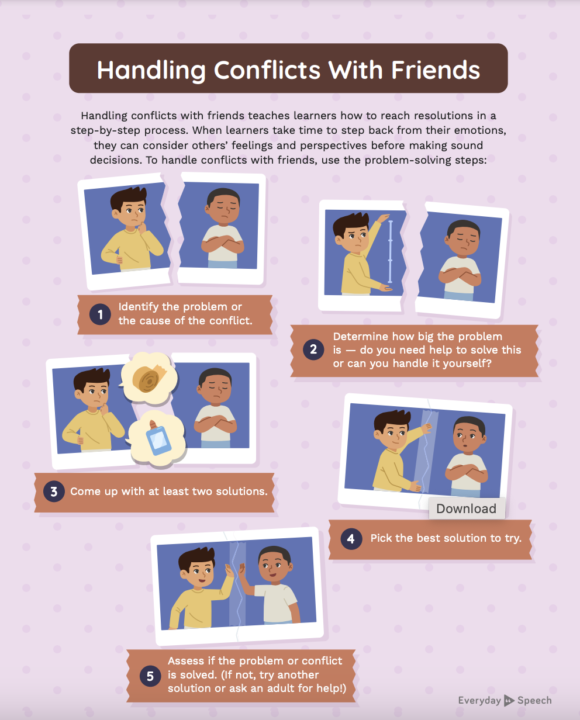Download 30+ Printable Social Skills Posters
Ready-to-use visuals for emotional regulation, self-advocacy, and more

Conflicts among friends are a natural part of growing up and learning social skills. For elementary students, handling these conflicts constructively can significantly impact their emotional and social development. As elementary school teachers, social workers and counselors, you play a crucial role in guiding students through conflict resolution. Everyday Speech’s goal poster provides a structured approach to help students manage conflicts with friends effectively. This blog post will explore how to use this poster in helping elementary students handle conflicts with friends.
Why Conflict Resolution Matters
Teaching conflict resolution is essential for elementary students because it:
- Promotes Healthy Relationships: Helps students maintain positive friendships.
- Enhances Problem-Solving Skills: Encourages critical thinking.
- Builds Emotional Intelligence: Teaches students to understand and manage their emotions.
- Reduces Classroom Disruptions: Minimizes conflicts that can interrupt learning.
Everyday Speech’s Goal Poster for Conflict Resolution
Everyday Speech’s goal poster outlines a clear, step-by-step process for resolving conflicts. The steps include:
- Identify the problem/cause of conflict
- Determine how big the problem is/can you handle it yourselves
- Come up with two solutions
- Pick the best solution to try
- Assess if the problem is solved

Lesson Plan: Teaching Conflict Resolution with the Goal Poster
Objective
By the end of the lesson, students will be able to identify the cause of a conflict, determine the severity of the problem, generate solutions, choose the best solution, and assess if the conflict is resolved.
Materials Needed
- Everyday Speech’s goal poster for conflict resolution
- Whiteboard and markers
- Reflection journals or worksheets
- Printable conflict resolution scenarios (optional)
Duration
45-60 minutes
Activity Steps
1. Introduction to Conflict Resolution (10 minutes)
Begin the lesson by discussing what conflict is and why it occurs. Explain that conflicts are a normal part of friendships and can be resolved in positive ways. Use relatable examples to illustrate common conflicts among friends, such as disagreements over games or misunderstandings.
Discussion Questions:
- What is a conflict?
- Why do conflicts happen?
- How do you usually feel during a conflict?
2. Introducing the Goal Poster (10 minutes)
Introduce the Everyday Speech goal poster to the class. Explain each step in the conflict resolution process and how it helps resolve conflicts constructively. Use the whiteboard to illustrate each step and provide examples.
Steps on the Poster:
- Identify the Problem/Cause of Conflict: Encourage students to clearly state what the conflict is about.
- Determine How Big the Problem Is/Can You Handle It Yourselves: Help students assess the severity of the conflict and decide if they need adult assistance.
- Come Up with Two Solutions: Guide students to brainstorm possible solutions to the conflict.
- Pick the Best Solution to Try: Discuss how to evaluate solutions and choose the best one to implement.
- Assess if the Problem Is Solved: Teach students to reflect on the outcome and determine if the conflict is resolved.
3. Role-Playing Scenarios (20 minutes)
Divide students into pairs or small groups and provide them with conflict resolution scenarios. Ask them to role-play each scenario using the steps outlined on the poster. This hands-on practice helps students apply the conflict resolution process in real-life situations.
Example Scenarios:
- Two friends disagree about what game to play during recess.
- A student feels left out because their friend didn’t invite them to a party.
- A misunderstanding leads to hurt feelings between classmates.
Role-Playing Steps:
- Identify the Problem: Each pair identifies the conflict in their scenario.
- Determine the Severity: They discuss whether they can handle it themselves.
- Brainstorm Solutions: They come up with two potential solutions.
- Choose a Solution: They select the best solution to try.
- Assess the Outcome: They reflect on whether the problem is resolved.
4. Group Discussion and Reflection (10 minutes)
After the role-playing activity, gather the students for a group discussion. Ask them to share their experiences and reflections on the conflict resolution process. Encourage them to discuss what they learned and how they felt during the role-playing activity.
Reflection Questions:
- What was the conflict in your scenario?
- How did you feel during the conflict?
- What solutions did you come up with?
- Was the conflict resolved? How do you know?
5. Reflection Journals (10 minutes)
Provide students with reflection journals or worksheets to document their thoughts and feelings about the conflict resolution process. Encourage them to write about a real conflict they experienced and how they could use the steps on the goal poster to resolve it.
Journal Prompts:
- Describe a conflict you had with a friend.
- How did you feel during the conflict?
- What steps did you take to resolve the conflict?
- What could you do differently next time?
Unlock all of our friendship materials by signing up for your free trial today – no credit card required!
Access the full Social Communication Curriculum HERE!
Instant access to thousands of no-prep social skills activities, over 1000+ video lessons, and engaging games designed to enhance learning and development.
Conclusion
Helping elementary students handle conflicts with friends is essential for their social and emotional development. Everyday Speech’s goal poster provides a structured and effective approach to conflict resolution, helping students develop critical skills for managing conflicts constructively. By following the lesson plan and incorporating regular practice, elementary school social workers can support students in building strong, positive relationships with their peers. For more resources and tips on teaching conflict resolution, stay tuned to our blog.
Sample Video
Try out this sample animated video lesson.
We offer our entire Social-Emotional Learning platform free for 14 days here!
Related Blog Posts:
Free Elementary Conversation Topics Material
Promote Social Understanding in Elementary Students with Educational Videos
Enhance Social Skills in Elementary Students with Free Video Resources

